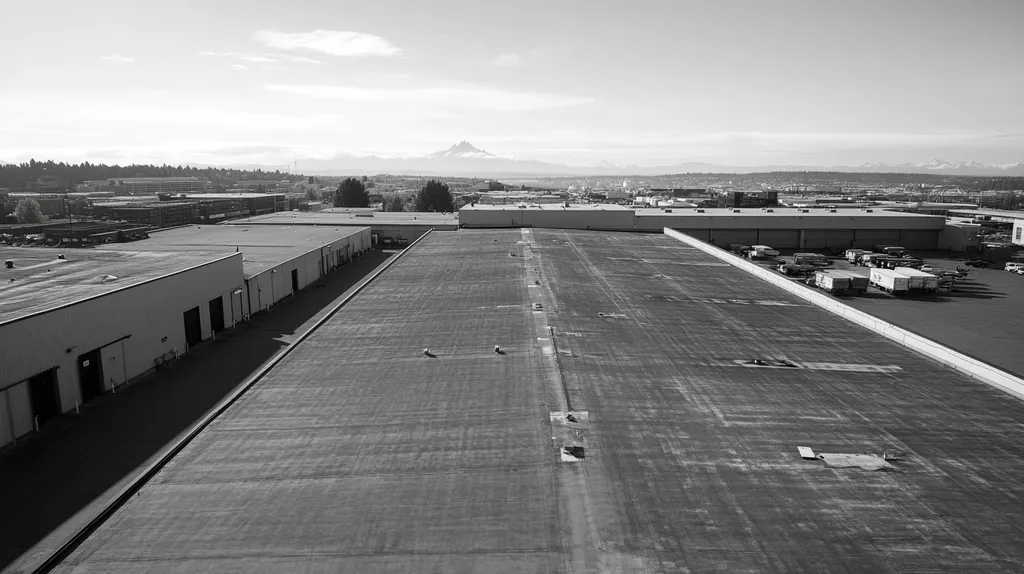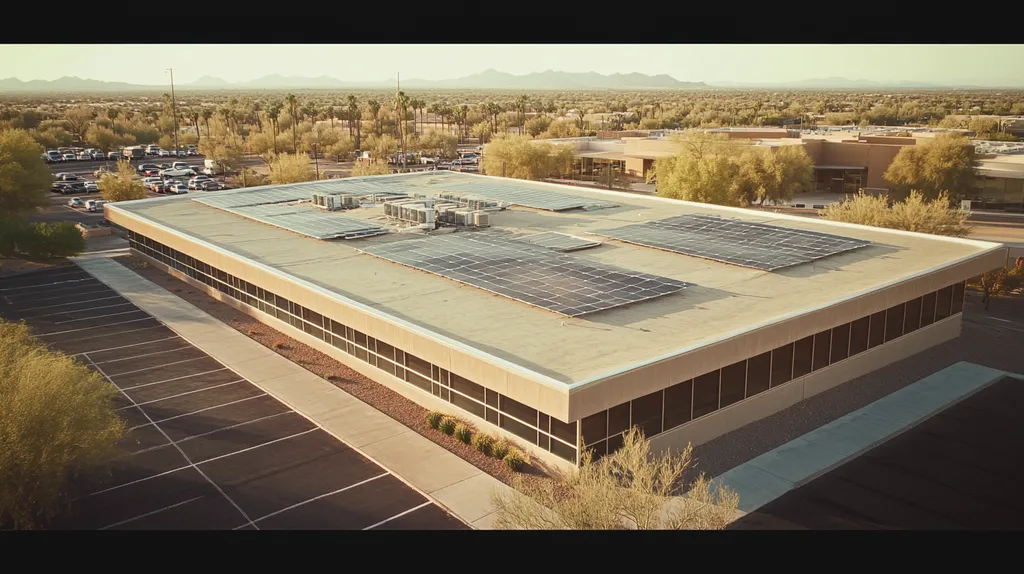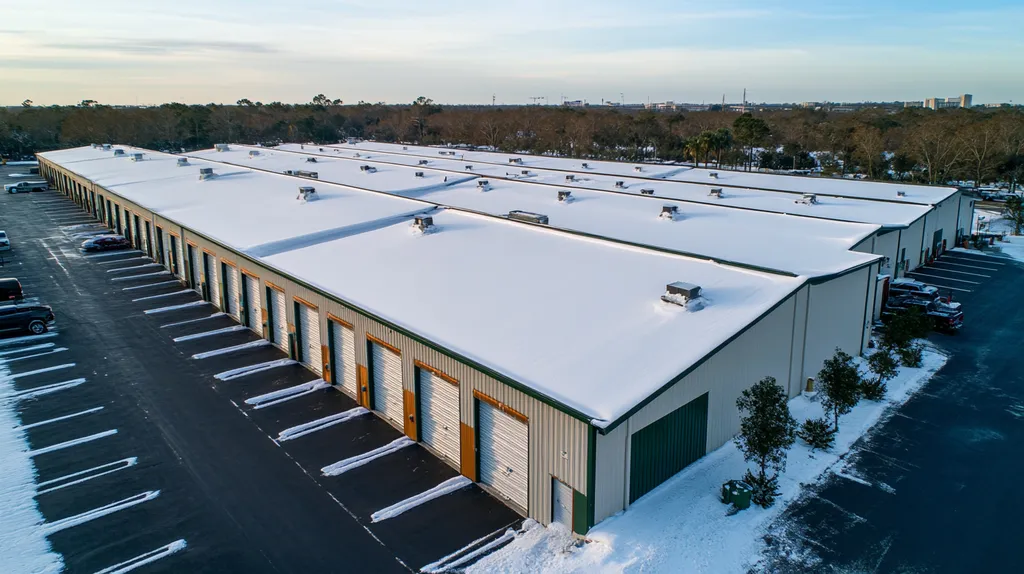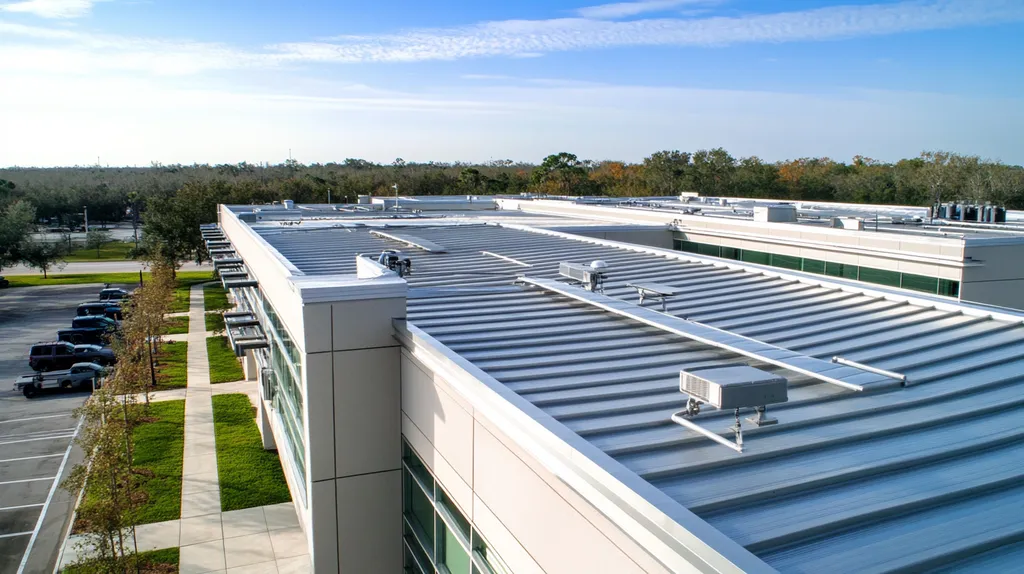In an era of soaring energy costs, commercial property owners are leaving money on the table by ignoring one of the most effective efficiency solutions available: white roofing. Studies show these systems can slash cooling expenses by up to 30% while extending roof lifespan by decades.
Yet despite proven results, many facilities continue struggling with dark roofs that transform buildings into giant heat sponges during summer months.
This comprehensive guide cuts through the marketing hype to deliver practical insights on white roofing implementation, maintenance requirements, and real-world performance metrics that impact your bottom line.
SECTION 1: THE BASICS EXPLAINED
The commercial roofing landscape is undergoing a seismic shift, with energy-efficient solutions rising to the forefront—and white roofing is leading the charge. Research shows that these roofs can bounce back a staggering 85% of sunlight, slashing cooling costs significantly. This section delves into the fundamentals of white roofing, spotlighting its vital role in enhancing energy savings, reducing environmental harm, and improving overall building performance.
What It Is (In Plain Language)
At its core, white roofing is a specialized roofing material built for reflection. Unlike traditional dark roofs that absorb heat like a black kettle on a sunny day, white roofs push sunlight away. This category includes coatings and membranes primarily in white or light tones, crafted to keep your building cooler.
Materials can vary, featuring options like TPO (Thermoplastic Olefin), PVC (Polyvinyl Chloride), or reflective coatings applied to existing roofs. What matters is their shared ability to stay cool under the blazing sun.
White roofing isn’t just a passing trend; it’s a savvy strategy that property owners and facility managers can leverage to boost energy efficiency. The rewards shine through in both reduced cooling expenses and a commitment to sustainability.
With white roofing, owners can dramatically minimize the oppressive heat absorption common with darker roofs, creating a more comfortable indoor atmosphere for tenants and employees alike.
Why It Matters (To Your Building)
White roofing isn’t just about looking good; it’s a powerhouse of benefits. One of the most noticeable perks is the sharp decrease in cooling costs, making it a financially wise decision for property owners. Commercial properties often grapple with soaring energy expenses due to extensive heating and cooling needs, and white roofs step up to tackle this challenge head-on.
But the advantages don’t stop at the bottom line. White roofing promotes better indoor air quality and occupant comfort. By reflecting sunlight, these roofs help maintain cooler interiors, which leads to reduced air conditioning requirements and a more pleasant work environment.
Plus, there’s a bigger picture at play: adopting white roofing aligns with environmental stewardship. By lowering energy consumption, buildings with white roofs help cut down on greenhouse gas emissions, appealing to tenants and clients eager to make sustainable choices.
On top of that, properties flaunting energy-efficient roofing often find themselves more marketable. Environmentally conscious businesses are increasingly prioritizing features that help reduce their ecological footprint.
How It Works
The magic behind white roofing rests on a simple yet powerful principle: reflection. Light-colored surfaces repel a hefty chunk of sunlight, preventing it from seeping into the building. This natural approach minimizes reliance on mechanical cooling, so property owners can trim their energy bills.
The technology used in white roofing often incorporates reflective coatings that can rejuvenate older roofs. These coatings amplify the roof’s ability to bounce back sunlight while providing essential protection from wear and tear.
Furthermore, cool roofs counteract the urban heat island effect, where city areas can be significantly warmer than their rural surroundings. Embracing white roofing on a broader scale can help communities bring down overall temperatures.
Add to that the longer lifespan of many white roofing materials compared to traditional options. Superior durability means fewer repairs and replacements, turning into even more savings for property owners over time.
SECTION 2: PRACTICAL APPLICATIONS
The call for energy efficiency is impossible to ignore in today’s commercial landscape. With the U.S. Department of Energy reporting that reflective roofs can slash surface temperatures by up to 60 degrees Fahrenheit, the financial implications are enormous. This dramatic cooling effect can lead to tangible savings on cooling costs and a reduced carbon footprint. Understanding how to leverage white roofing can open the door to significant long-term benefits and sustainability for commercial properties.
Common Uses & Examples
White roofing systems are gaining traction across a variety of commercial settings, from warehouses to retail stores. Take, for instance, a distribution center situated in a sun-soaked area. By upgrading to a white roofing solution, this facility managed to lower its cooling bills by around 30% annually. Now that’s a bright idea!
Hospitals and schools are also jumping on the white roofing train. With large, expansive rooftops at their disposal, these structures benefit significantly from the reflectivity of white materials. The result? More stable indoor temperatures and improved air quality—critical factors for health and learning.
Don’t assume white roofing is limited to flat roofs, either. Some innovative sloped roofing systems are using lighter-colored materials to drive energy efficiency. For example, an office in Phoenix saw a significant dip in air conditioning demands after switching to a sloped white roof.
In every corner of the commercial space, countless success stories illustrate the versatility and financial advantages of white roofing solutions.
When You Need It Most
The necessity for white roofing becomes particularly clear in high-heat regions. Properties in these areas often struggle with skyrocketing cooling costs without effective insulation strategies. Here, white roofing shines, offering substantial savings, especially during those sweltering summer months.
Additionally, aging roofing systems should be prime candidates for white roofing solutions. Whenever a roof is up for replacement or significant repairs, opting for reflective materials can lead to quick energy savings and extend the lifespan of the structure.
Moreover, properties pursuing sustainability certifications should consider white roofing. Many green building standards recognize roof reflectivity as a key factor, which can translate into better marketability and possibly financial incentives.
In short, knowing when to implement white roofing is vital to maximizing benefits and ensuring a sound investment.
Interactions With Other Systems
White roofing systems can play nicely with other energy-saving technologies. For instance, adding a white roof can significantly enhance the performance of photovoltaic systems. Cooler roofs allow solar panels to operate more efficiently, boosting electricity generation.
Moreover, white roofing complements green landscaping strategies, including green roofs. This combination not only further reduces heat absorption but also enhances stormwater management and biodiversity within urban settings.
Integrating advanced insulation materials with white roofing compounds the benefits. Improved insulation minimizes heat transfer, upping the ante on potential energy savings. Property owners can tap into a well-rounded energy efficiency plan through these synergistic interactions.
By recognizing these interactions, commercial properties can secure substantial returns on investment while pushing the envelope on sustainability and efficiency.
SECTION 3: KEY TERMINOLOGY DECODED
Navigating the ins and outs of white roofing terminology isn’t just a side quest—it’s a necessity. With mounting pressure on property owners and facility managers to curb energy costs and up the sustainability ante, grasping the right terms is the key to making decisions that actually pay off. Armed with this knowledge, stakeholders can sidestep costly mistakes and leap towards efficiency.
Essential Terms Explained
Let’s kick things off with “cool roofing.” This term refers to roof systems engineered to reflect a greater amount of sunlight while absorbing less heat than your average rooftop. The result? Noticeably lower energy bills as these roofs work to keep building interiors at more comfortable temperatures during the hot summer months.
Next up is “reflectance,” the percentage of solar radiation that a roof can effectively bounce back. Higher reflectance percentages mean better performance in warding off heat absorption—essential for any energy-efficient plan.
Another critical metric is the “SRI” or Solar Reflectance Index. This number combines both reflectance and emissivity into one score, providing a fuller picture of a roof’s efficiency. An SRI rating of 78 or above typically signifies robust performance for white roofing systems.
Finally, “emissivity” is all about how well a roofing material radiates absorbed heat. Materials that hold onto heat—those with low emissivity ratings—intensify cooling costs. In contrast, high emissivity materials release heat efficiently, contributing to greater energy savings for building owners.
Industry Jargon Translated
Let’s decode some specific industry lingo. “TPO,” short for Thermoplastic Olefin, stands out as a popular white roofing membrane celebrated for its energy efficiency. These roofs are lightweight and often wallet-friendly, boasting high reflectance, making them a go-to for commercial buildings.
Then there’s “PVC,” or Polyvinyl Chloride, pulling its weight as another widely used roofing option. While TPO and PVC both offer high reflectance and energy savings, PVC often gets the nod for its durability in extreme conditions, positioning it as a favorite for various commercial structures.
The term “Energy Star” pops up when discussing roofing materials that meet stringent energy-saving criteria. Products that earn this badge usually showcase high reflectance and emissivity ratings, signaling their effectiveness in boosting energy efficiency.
Lastly, “LBP,” or “low slope roofing,” describes roofs with slopes less than 3:12. These roofs call for careful waterproofing and drainage design. Good news: white roofing materials like TPO and PVC excel on low-slope roofs due to their flexible installation capabilities.
Measurement & Units Simplified
When it comes to roofing projects, understanding measurements is paramount. “Square feet” is the primary unit of area, giving property owners a way to accurately assess project dimensions and associated costs.
In this realm, “thermal resistance” is important too, often referred to as the R-value. This value represents a material’s insulating power—the higher it is, the better the insulation, which can lead to lower energy bills over the years.
Reflectance values are expressed in percentages, typically ranging from 0% to 100%. A higher percentage indicates a more reflective surface, which is critical for achieving energy savings.
Finally, be on the lookout for costs presented as “cost per square foot.” This straightforward measure helps property owners evaluate expenses against potential energy savings, ensuring they choose the most cost-effective roofing solution.
SECTION 4: DECISION FACTORS
When it comes to selecting the right roofing option for a commercial property, it’s not just about choosing something that looks good. It’s about making a decision that could have a lasting impact on energy costs and the environment. With energy prices climbing, property owners need roofs that actually deliver on efficiency. White roofing systems promise to offer measurable advantages, but it’s essential to weigh factors like cost, performance, and durability to truly capitalize on those benefits.
Cost Considerations
While the initial expense of white roofing can be daunting, it’s crucial to look past that first price tag. Yes, it may cost more upfront compared to traditional options, but here’s the kicker: white roofs can slash cooling costs by up to 30%. Those savings on utility bills pay off in the long run and make that initial investment look pretty smart.
Don’t forget to check for local and federal incentives, too. Many regions provide tax credits or rebates for property owners who switch to energy-saving roofing systems. This financial support is like a bonus that can ease the budgetary pinch.
Property owners should also factor in maintenance costs. Though white roofs may require more frequent cleaning to remain effective, their durability often means fewer repairs. A well-rounded cost analysis can give owners a clearer picture of the financial journey ahead.
Overall, grasping these cost dynamics is critical for making informed roofing decisions that stand the test of time.
Performance Trade-offs
White roofs come with fantastic benefits, but they also have performance trade-offs that shouldn’t be ignored. For instance, not every material holds up well in extreme weather. Buildings in areas with heavy rain might need specialized options to defend against leaks and damage.
The climate is a big factor in performance as well. In hotter regions, white roofs excel at cooling down buildings, while in frigid environments, retaining heat could be a higher priority. Understanding local weather patterns is essential for making the right roofing choice.
It’s also vital to think about how the roof will interact with existing building materials. Compatibility can make or break energy performance and durability. Proper installation by qualified professionals is key to ensuring that all system components work together.
Ultimately, balancing energy efficiency with performance details guarantees that every roofing investment delivers the desired operational results.
Lifespan & Durability Factors
The lifespan and durability of a white roofing system are pivotal when considering long-term value. Many white roofs can last 20 years or more if you choose the right material. That means lower replacement costs and increased peace of mind down the road.
However, not all materials are created equal. Opting for robust options like TPO or white PVC is smart; they offer excellent protection against UV rays and general wear and tear. These durable materials can keep their reflective capabilities much longer.
Assessing how well the roofing system can withstand foot traffic and potential punctures is equally important. Greater durability often leads to fewer repairs and less risk of leaks, giving property owners more bang for their buck.
By conducting a thorough evaluation of durability and lifespan factors, property owners can make well-informed decisions that ensure their roofs will stand strong for years to come.
SECTION 5: COMMON CHALLENGES
Adopting white roofing for commercial properties isn’t all sunshine and energy savings. Property owners and facility managers face a slew of challenges that can threaten their investment. From urban heat complications to rising maintenance costs and potential roof degradation, understanding these issues is critical for maintaining energy efficiency and maximizing cost savings.
Frequent Problems & Solutions
One significant hurdle with white roofing is the build-up of dirt and debris, which can compromise the reflective surface and diminish energy efficiency. Implementing a regular cleaning schedule is essential—think of it as giving your roof a spa day—to keep its reflective capabilities shining bright.
Another common problem is membrane punctures or tears. The lightweight materials used in many white roofing systems can be prone to wear and tear. Fortunately, incorporating protective barriers or specialized coatings can help safeguard these sensitive areas from damage, thereby extending the roof’s lifespan.
Urban heat island effects can also complicate performance. Without proper installation, surrounding buildings may reflect excessive heat, leading to higher energy costs. Hiring experienced contractors ensures the roof is applied correctly, maximizing its cooling benefits.
Finally, severe weather conditions can take a toll on white roofing. Intense UV rays and heavy rains can cause wear over time. Conducting routine inspections can catch early signs of damage, allowing for timely fixes that prevent more serious issues down the road.
Warning Signs To Watch For
Property owners should stay alert for specific warning signs that could spell trouble for their roofing system. One glaring red flag is visible discoloration, which often indicates a loss of reflective capabilities. This can lead directly to increased energy costs—definitely not something to ignore.
Cracking or blistering on the roofing membrane can also signal deeper issues. Such problems may result in leaks or even total system failure. Identifying these issues early on can save property owners from extensive damage and costly repairs.
Pooling water is another telltale warning sign. This condition not only invites leaks but also accelerates the deterioration of materials. Investing in effective drainage solutions is vital to thwarting these water-related challenges.
Lastly, a noticeable spike in energy bills often points to underlying issues with the roofing system. When costs start tilting upward unexpectedly, it’s time for a thorough inspection to spot potential damage or dirt buildup.
Preventative Approaches
Embracing preventative maintenance can revolutionize how commercial properties manage their white roofs. Establishing regular cleaning routines is crucial to maintain reflective surfaces and ensure optimal energy performance. Scheduling cleanings at least twice a year is typically sufficient.
Installing a monitoring system can provide real-time insights into the roof’s condition, allowing for proactive maintenance. Catching issues early can save property owners significant repair costs in the future.
Choosing high-quality materials is another key strategy for prevention. Investing in durable, weather-resistant membranes pays off by dramatically extending the lifespan of a white roofing system.
Lastly, equipping maintenance staff with knowledge about potential white roof issues empowers them to act quickly and effectively. A well-informed team can spot early signs of wear, ensuring the roof stays in top-notch condition.
SECTION 6: NEXT STEPS & RESOURCES
As the push for energy efficiency ramps up, property owners can’t afford to ignore the significant advantages of white roofing. Studies indicate that these reflective roofs can slash energy costs by up to 30%, making a real impact on the bottom line. To harness these benefits, it’s essential to know how to implement white roofing effectively and integrate it into your overall energy strategy.
Questions To Ask Providers
Selecting the right roofing provider is crucial for a successful white roofing project. Property owners should dive into the specifics of the reflective materials used and the promised long-term performance. Questions like, “How do your roofing solutions stack up against energy efficiency standards?” and “What warranties are in place for energy performance?” are key to setting clear expectations.
It’s equally vital to discuss installation and maintenance practices. Providers worth their salt will have detailed procedures to ensure the roof remains effective throughout its lifespan. Engaging in meaningful conversation on these topics highlights their expertise and dedication to quality work.
Don’t shy away from requesting case studies or examples from their past projects. It’s illuminating to see how they’ve fared with similar buildings and what results they’ve achieved. Understanding their approach to customer service can also be a game changer; ongoing support can really make a difference.
By asking these targeted questions, property owners can align themselves with a provider who not only understands the ins and outs of white roofing but is also committed to boosting energy efficiency and sustainability.
Industry Standards & Guidelines
Awareness of industry standards is critical for reaping the full benefits of white roofing. The Cool Roof Rating Council (CRRC) sets forth guidelines regarding the reflective properties of roofing materials, helping owners make informed choices. Knowing the minimum reflectivity necessary for energy efficiency will shape the selection process.
The U.S. Green Building Council’s frameworks, like LEED certification, support eco-friendly upgrades, ensuring compliance with regulations while potentially unlocking tax incentives. Meeting these standards is beneficial for both the environment and a property’s marketability.
By following best practices from the National Roofing Contractors Association (NRCA), property owners can enhance the durability and performance of their white roofing systems. Becoming familiar with these industry benchmarks is vital for maintaining quality and ensuring sustainability.
Sticking to these guidelines not only advances energy efficiency but also makes properties more appealing to tenants and buyers alike.
Further Learning Simplified
For property owners looking to deepen their understanding of white roofing, a wealth of resources awaits. Websites like the U.S. Environmental Protection Agency (EPA) offer invaluable insights into energy-efficient roofing options and their environmental perks. Online learning platforms such as Coursera and Udemy provide courses to boost one’s technical know-how.
Industry publications like Roofing Contractor and Professional Roofing frequently showcase articles and case studies centered around white roofing technology. Subscribing to these sources keeps owners informed about the latest research, trends, and product advancements.
Networking at industry conferences can be incredibly beneficial. Events like the International Roofing Expo allow for direct interaction with experts, panel discussions, and product showcases, enriching knowledge and contacts.
With the right resources and a proactive attitude, property owners can make informed decisions leading to notable energy savings and superior building performance.
The Bottom Line
With energy costs continuing to rise and climate pressures mounting, white roofing represents one of the smartest investments available to commercial property owners today.
The numbers tell a compelling story: up to 30% reduction in cooling costs, 85% solar reflectivity, and potential decades added to roof lifespans.
Yet despite these proven benefits, countless buildings still bake under dark roofs while property owners leave money on the table.
The technology exists, the ROI is clear, and the environmental impact is significant.
The question is no longer whether to implement white roofing solutions, but rather how quickly property owners can make the switch to start capturing these critical efficiency gains.
FREQUENTLY ASKED QUESTIONS
Q. What is a commercial roof in relation to white roofing?
A. A commercial roof refers to roofing systems used in commercial buildings. White roofing is a key feature here, as it enhances energy efficiency and reduces cooling costs. By reflecting sunlight, these roofs can significantly improve comfort and sustainability, making them a smart choice for commercial properties.
Q. How can white roofing benefit an industrial roof?
A. White roofing benefits industrial roofs by reducing heat absorption, leading to lower cooling costs. This is particularly advantageous for facilities with large rooftops, as it can lead to substantial energy savings and improved indoor conditions, resulting in a more comfortable working environment for employees.
Q. What are the common applications for commercial roofs using white roofing?
A. White roofing is commonly used on warehouses, retail stores, hospitals, and schools. These structures often benefit from the reduced heat gain and improved energy efficiency, making them prime candidates for this roofing option. It’s also adaptable to various roofing styles, including both flat and sloped roofs.
Q. What should property owners consider about the cost of commercial roofs?
A. Property owners should weigh the upfront costs against long-term savings on cooling bills. While white roofing may come with a higher initial investment, it can save significantly on energy expenses over time. Additionally, they should explore available tax incentives that can offset costs.
Q. What challenges do commercial properties face with white roofing?
A. Common challenges include dirt accumulation, membrane damage, and urban heat effects. Regular maintenance is essential to maintain reflectivity and performance. Understanding potential impacts from the local environment and investing in quality materials can mitigate many of these challenges.
Q. How can property owners prepare for installing white roofing?
A. Property owners should research various materials and assess their roofs’ specific needs. Consulting with experienced contractors is key to discussing the installation process and maintenance requirements. Establishing a maintenance plan upfront can help maximize the roof’s effectiveness and lifespan.
Q. What resources can help learn more about white roofing?
A. Valuable resources include the U.S. Environmental Protection Agency, industry publications, and online learning platforms. Attending industry conferences or reviewing case studies can also provide in-depth knowledge about energy-efficient roofing and best practices.










